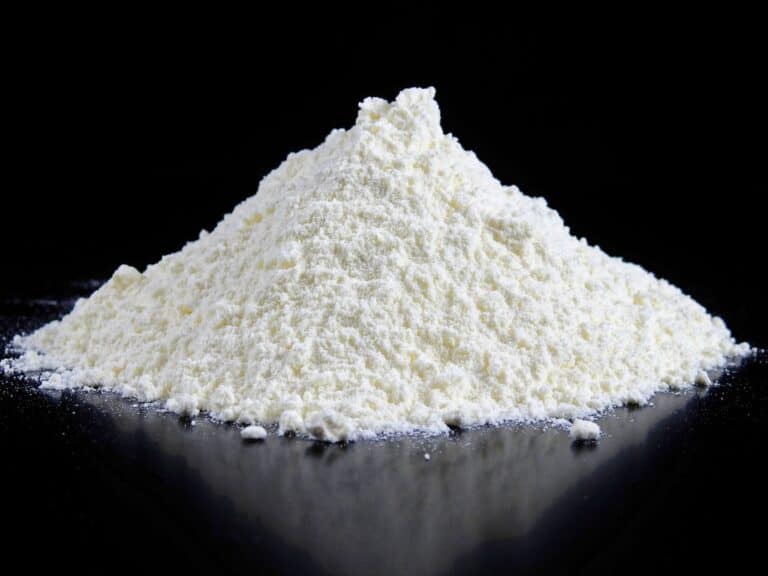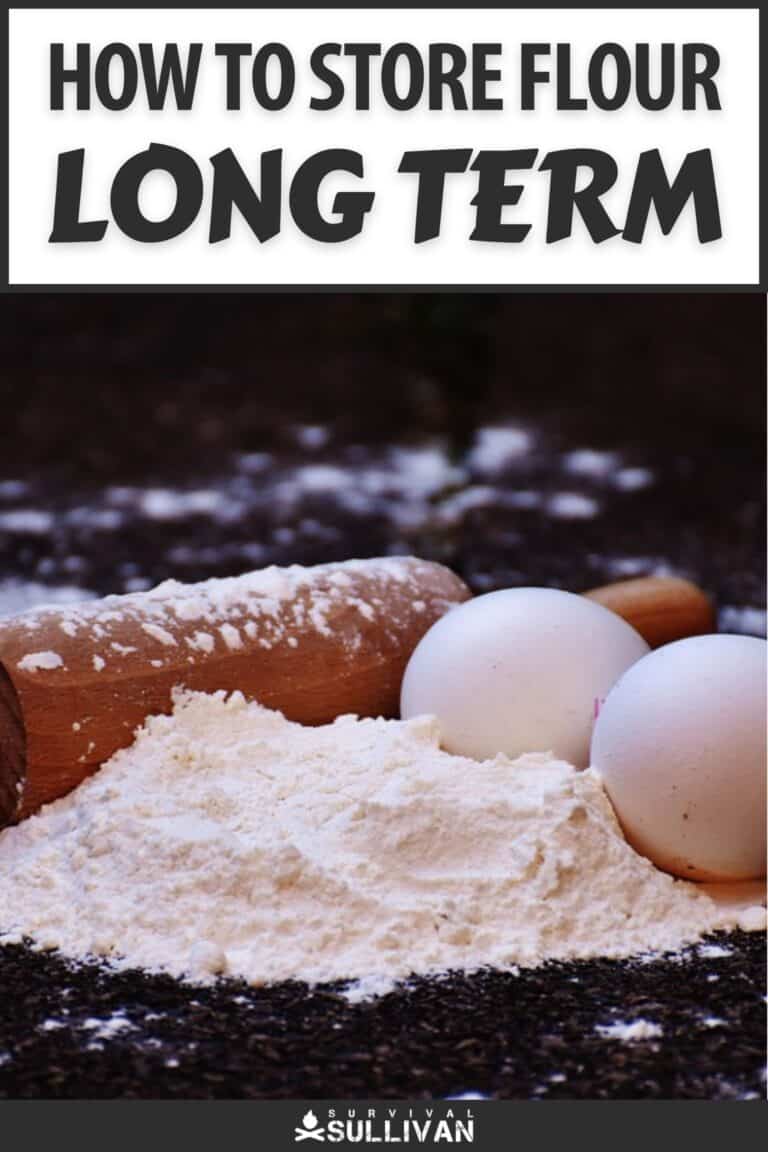Flour is one of those staples found in every pantry across the globe. It’s used in cuisine from every culture in the world as it’s the main ingredient in many kinds of pasta, bread, and other baked goods.

Unfortunately, flour has a shorter than expected expiration date since it is greatly affected by bugs and moisture.
While it is considered a non-perishable food there are several conditions that can quickly make your stock of flour go bad, this includes incorrect storage conditions, weevil infestations, molds, and even just plain going stale.
This guide is meant to show you how to maximize the shelf life of your flour so that you can stock up and keep a supply in case it ever becomes difficult to come by.
Keep reading to learn more about different storage types and why it really matters to choose the right method for your needs.

How Long Does Flour Last?
Buying flour from the grocery store is the main way people get their supply. The thin, double-layered bag will only go so far as to preserve the integrity of your flour.
You might think that putting an elastic band around the bag or storing it in a large ziploc bag will help preserve it, but you’d be surprised at where air can get in.
Does Flour Go Bad?
Left out in the air, the nutrients in the flour will go stale and you’ll have an odd, sour taste with anything you create with it.
If you’re using whole grain flour then the oils inside can go rancid and spoil the batch.
Weevils are a pest that lay their eggs inside flour. As several weeks pass these little worms will hatch and start to eat their way out of it.
As they mature, they turn into flying moth-like insects that gland lay more eggs as the cycle renews.
The tricky thing with them is that they lay their eggs in the flour before it is sold in the market which means it already has them when you bring it home.
Moisture can cause your flour to mold quickly and without warning. Even the humidity in the air can be enough to activate life for some spores.
How Many Years Can Flour Be Stored?
The flimsy paper bag that your flour comes in will only net you about 6 months of shelf life, maybe a little longer if your storage conditions are good enough.
If you go all out and store your flour in vacuumed sealed mylar bags then you will easily get 10 or more years out of it.
Other methods include storing in an airtight bucket with oxygen absorbers, which will get you between 5-10 years of shelf storage.
Keep in mind that these are all based on optimal storage conditions, if you expose the flour to heat, light, or air then the shelf life is considerably shortened.
| Storage Type | Length of Time |
|---|
| Paper bag or Ziploc | 6-8 months |
| Airtight container/ oxygen absorbers | 5-10 years |
| Mylar/vacuum sealed | 10+ years |
| Freezer | Indefinitely |
Signs That Your Flour Has Gone Bad
Flour is a sensitive ingredient to the environment around it, which means it can spoil easily but will also be easy to tell when it has spoiled. Here are some of the signs that your flour has gone bad.
- A sour or rancid smell when you open the package. It’s like the smell of Playdough.
- If you bake with it you’ll taste the same sour musty smell
- Little brown bugs called weevils will be seen throughout the flour
- Flour mites are almost impossible to see and are present when there is mold. They are known for eating the germ part of the flour.
The Types of Flour And Their Shelf Life
Different flours have their own storage requirements based on how much processing was done to them.
Whole grain flours have every part of the wheat intact and naturally has a shorter life since the oils inside can go rancid.
Enriched flours have all of the internals taken out, essentially eliminating any oils that may be inside. This lower moisture content gives white flour much longer on the shelf.
| Flour Type | Shelf Life |
|---|
| All-purpose flour | 6 -12 months |
| Whole wheat flour | 3-6 months |
| Bread flour | 5-9 months |
| Cake flour | 6-9 months |
| Self-rising flour | 5-7 months |
| Rye flour | 4-6 months |
| Oat flour | 3 months |
| Barley flour | 3 months |
| Alternative flours | 3-5 months |
The Best Ways To Seal Flour For Long-Term Storage
Storing your flour right away is the best solution to avoid any issues with preservation. There is a myriad of ways to get this process completed.
Some methods are designed to use minimal space while others guarantee a long shelf life, but take up more room. Here are some of the best ways for you to store your flour on any type of budget.
1. Storing Flour In The Fridge and Freezer
A surefire way to keep your flour fresh forever is to store it in the freezer in an airtight container. This will suspend any organic actions taking place and keep it fresh until you need it.
When you do need to use it, simply take it out of the freezer and let it stand until it gets to room temperature.
Don’t use the flour while it is cold if you need yeast in your recipe. Yeast becomes inactive in cold temperatures and your baked goods won’t rise.
Some people will freeze their flour when they get it to kill off any insects that may have laid eggs in your flour. This is a step in many flour preservation protocols that you’ll find today.
2. Storing Flour In Buckets
Storing flour in buckets is doable, but most people use it as a container for their storage containers.
Mylar bags for example can be punctured or creased which can affect their integrity.
Keeping them in a large plastic pail will keep mice and the elements from getting into your flour.
3. Sealing Flour in Mylar Bags
This is one of the best ways to store your flour because mylar bags are impervious to outside conditions.
This means that no oxygen, moisture, light, or heat will make their way into the bag, potentially spoiling your flour stock.
Mylar bags are formed with thin layers of plastic and aluminum foil that form a hermetic-like seal on anything you store.
They are generally heat-sealed using something like a clothes iron. This seal will keep your food fresh for over a decade under ideal storage conditions.
4. Oxygen Absorbers
Oxygen absorbers are little packets of iron filaments that oxidize over time.
The iron turns to rust when exposed to oxygen and replaces it with nitrogen, which is considered an inert gas. The packets themselves are non-toxic and your food will be safe from contamination.
You can find them in anything that’s been vacuum-sealed or dry-preserved as an added precaution against oxygen exposure. By adding one of these to something like a mylar bag you can add years onto its shelf life.
Additionally, oxygen absorbers are a great way to deal with insects since their eggs cannot hatch if there is no air present.
This means those pesky weevils won’t be able to hatch and start to eat your flour supply from the inside out.
5. Vacuum Sealing
Once only available for commercial products, vacuum sealers have made their way into a lot of homes. Better technology and cheaper parts have made these machines affordable for everyone.
Vacuum sealing removes all of the oxygen from the inside of a container.
Commonly, vacuum sealing bags are used since they are made of a special plastic that is impermeable.
Mylar bags are excellent candidates for vacuum sealing and a lot of them have ports available for various vacuum sealing machines.
You can even find resealable mylar bags which can be opened and closed again without any harmful effects to the food.
The Disadvantages of Storing Flour Long Term
While the benefits are clear when considering long-term storage for your flour, you still have to assess your current situation. Here are some of the factors that can be included in your long-term storage plan.
It Can Be Quite Expensive
Considering the materials that are needed for storing flour long-term: mylar bags, plastic buckets, oxygen absorbers, and vacuum sealers, you can see how the cost will add up.
It Is Not 100% Foolproof
Defects are common in mass-produced items and there could be times when your food might experience issues.
Holes in bags, broken seals, and other defective materials can cause rapid degradation of your food if not monitored.
It Can Take Up a Lot of Space
If you’re prepping for a length outage then you’ll be stocking up on more than flour. This means you will have limited square footage for investing in your grain stash.
Final Thoughts
Who knew that storing flour long-term would be such an involved endeavor, right?
Keeping these basic techniques in mind and ensuring you eliminate all outside environmental forces will keep your flour stash fresh for years to come.
Frequently Asked Questions
What happens if you use expired flour? Expired flour may still be okay if it was sealed tightly. Insects are generally harmless if you’re baking as they will die.
The taste and quality of the food may be affected however. If your flour has mold on it then it is best to discard as eating mold is not good for your health.
How do you prevent bugs from getting into your stored flour? Unfortunately, the bugs are more than likely laying their eggs in the flour before it even gets to your pantry.
You should consider it lucky if insects aren’t in your flour. The best prevention is to freeze your flour when you buy it to kill off any of the eggs that may be lurking.
Does flour get old? Flour will get old even with proper storing techniques. As with any food, the nutrients will start to break down and that compromises things like texture, taste, and overall look.
If your flour is old, it may still be consumable but the food might not be palatable.
How do you keep flour fresh? Keep your bagged flour fresh by keeping it out of reach of light, heat, and air. These are the catalysts for the creation of life within your flour.
Flour also absorbs scents, much like baking soda. It is wise not to keep your fresh flour next to a bag of onions as it may transfer the smell.

The post How To Store Flour Long Term – What You Need To Know appeared first on Survival Sullivan.
By: Perrin Adams
Title: How To Store Flour Long Term – What You Need To Know
Sourced From: www.survivalsullivan.com/how-to-store-flour-long-term/
Published Date: Tue, 01 Nov 2022 16:00:00 +0000
-------------------------------------------------------------------------
Did you miss our previous article...
https://outdoorsnewswire.com/survivalist/so-what-will-work-after-an-emp-attack-here-are-10-things-that-will
 CampingSurvivalistHuntingFishingExploringHikingPrivacy PolicyTerms And Conditions
CampingSurvivalistHuntingFishingExploringHikingPrivacy PolicyTerms And Conditions
